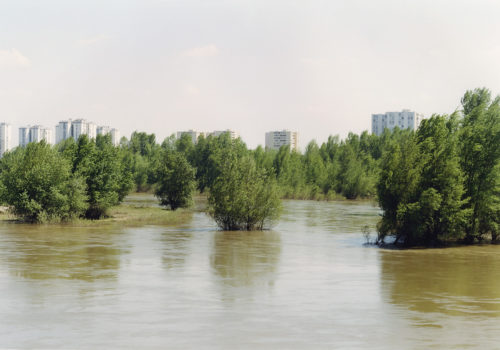The landscapes of the Loire captured by Thibaut Cuisset are exhibited at the Jeu de Paume in Tours, very close to the river. An opportunity to immerse yourself in one of the series of the photographer’s vast project. For L’Œil de la Photographie, his daughter, Camille Cuisset, co-curator of the exhibition alongside Quentin Bajac, answered our questions.
The exhibition presents photographs taken around the Loire. Was it a river and a corner of France that particularly inspired him?
Yes, the theme of the river interests him in general, because there is an intervention on the landscape. The river itself, but also all the activities that take place around the river. He worked on the Somme, the Seine and the Loire. The Loire is special in his work because he followed its entire course, the 1000 kilometers, he really liked the singular light around the river and therefore clearly emerges a series. All the town and country planning that this implies, ports for example, or even cultures, bridges … This is what we want to show with Quentin Bajac in this exhibition. But this series is really part of a larger project that consisted of photographing the French countryside and showing its diversity.
What is the genesis of this project?
He started this work in 1994 with the Landscape Photographic Observatory in Côtes-d’Armor and little by little he developed a passion for the French countryside. He was looking for what he called “intermediate spaces”, that is, spaces between city and countryside, between countryside and nature. He wanted to show them without pathos and with the closest possible distance, avoiding the human presence while showing traces of human activities.
How did he work?
He always prepared for his trips before going to the shooting locations. He would use IGN maps or road maps, then he would drive off, although he happened to walk too. He was alone most of the time. From his chosen route, he first scouted and then decided where to shoot. He worked with a large format camera and so in general he really looked for the point of view that suited him before settling there. After the shooting, he did a lot of editing work. He had been trained as a photographic printer and therefore made the prints himself. There is a continuity between the field and the tangible photo.
Was he influenced by painting?
Yes, his references are there first. In the painting, he quotes Paul Cézanne and Claude Monet, or even Gerhard Richter. And then also the cinema: Pasolini, Godard… He said that the light was better transcribed in the cinema of the 1980s than in photography.
What did photography represent to him?
He talked about it a little bit and I tried to find an answer … He wanted to get into documentary photography while leaving room for aesthetics. He had said a few times that it was in the Walker Evans documentary style. His project on the French countryside was a desire to show France and approach several types of landscapes. He called this project a “poetic and sensitive atlas”.
Interview conducted by Jean-Baptiste Gauvin
Thibaut Cuisset
Exhibition at the Château de Tours – Loire
November 25, 2021 – May 22, 2022
















